WHY DO SOME PEOPLE RESIST SCIENCE?
It is no secret that many American adults reject some scientific ideas. In a 2005 Pew Trust poll, for instance, 42% of respondents said that they believed that humans and other animals have existed in their present form since the beginning of time. A substantial minority of Americans, then, deny that evolution has even taken place, making them more radical than "Intelligent Design" theorists, who deny only that natural selection can explain complex design. But evolution is not the only domain in which people reject science: Many believe in the efficacy of unproven medical interventions, the mystical nature of out-of-body experiences, the existence of supernatural entities such as ghosts and fairies, and the legitimacy of astrology, ESP, and divination.
There are two common assumptions about the nature of this resistance. First, it is often assumed to be a particularly American problem, explained in terms of the strong religious beliefs of many American citizens and the anti-science leanings of the dominant political party. Second, the problem is often characterized as the result of insufficient exposure to the relevant scientific facts, and hence is best addressed with improved science education.
We believe that these assumptions, while not completely false, reflect a misunderstanding of the nature of this phenomenon. While cultural factors are plainly relevant, American adults' resistance to scientific ideas reflects universal facts about what children know and how children learn. If this is right, then resistance to science cannot be simply addressed through more education; something different is needed.
What children know
The main source of resistance to scientific ideas concerns what children know prior to their exposure to science. The last several decades of developmental psychology has made it abundantly clear that humans do not start off as "blank slates." Rather, even one year-olds possess a rich understanding of both the physical world (a "naïve physics") and the social world (a "naïve psychology"). Babies know that objects are solid, that they persist over time even when they are out of sight, that they fall to the ground if unsupported, and that they do not move unless acted upon. They also understand that people move autonomously in response to social and physical events, that they act and react in accord with their goals, and that they respond with appropriate emotions to different situations.
These intuitions give children a head start when it comes to understanding and learning about objects and people. But these intuitions also sometimes clash with scientific discoveries about the nature of the world, making certain scientific facts difficult to learn. As Susan Carey once put it, the problem with teaching science to children is "not what the student lacks, but what the student has, namely alternative conceptual frameworks for understanding the phenomena covered by the theories we are trying to teach."
Children's belief that unsupported objects fall downwards, for instance, makes it difficult for them to see the world as a sphere — if it were a sphere, the people and things on the other side should fall off. It is not until about eight or nine years of age that children demonstrate a coherent understanding of a spherical Earth, and younger children often distort the scientific understanding in systematic ways. Some deny that people can live all over the Earth's surface, and, when asked to draw the Earth or model it with clay, some children depict it as a sphere with a flattened top or as a hollow sphere that people live inside.
In some cases, there is such resistance to science education that it never entirely sticks, and foundational biases persist into adulthood. A classic study by Michael McCloskey and his colleagues tested college undergraduates' intuitions about basic physical motions, such as the path that a ball will take when released from a curved tube. Many of the undergraduates retained a common-sense Aristotelian theory of object motion; they predicted that the ball would continue to move in a curved motion, choosing B over A below.

An interesting addendum is that while education does not shake this bias, real-world experience can suffice. In another study, undergraduates were asked about the path that water would take out of a curved hose. This corresponds to an event that most people have seen, and few believed that the water would take a curved path.
Our intuitive psychology also contributes to resistance to science. One significant bias is that children naturally see the world in terms of design and purpose. For instance, four year-olds insist that everything has a purpose, including lions ("to go in the zoo") and clouds ("for raining"), a propensity that Deborah Kelemen has dubbed "promiscuous teleology." Additionally, when asked about the origin of animals and people, children spontaneously tend to provide and to prefer creationist explanations.
Just as children's intuitions about the physical world make it difficult for them to accept that the Earth is a sphere, their psychological intuitions about agency and design make it difficult for them to accept the processes of evolution.
One of the most interesting aspects of our common-sense psychology is dualism, the belief that minds are fundamentally different from brains. This belief comes naturally to children. Preschool children will claim that the brain is responsible for some aspects of mental life, typically those involving deliberative mental work, such as solving math problems. But preschoolers will also claim that the brain isn't involved in a host of other activities, such as pretending to be a kangaroo, loving one's brother, or brushing one's teeth. Similarly, when told about a brain transplant from a boy to a pig, they believe that you get a very smart pig, but one with pig beliefs and pig desires. For young children, then, much of mental life is not linked to the brain.
The strong intuitive pull of dualism makes it difficult for people to accept what Francis Crick called "the astonishing hypothesis." Dualism is mistaken — mental life emerges from physical processes. People resist the astonishing hypothesis in ways that can have considerable social implications. For one thing, debates about the moral status of embryos, fetuses, stem cells, and non-human animals are sometimes framed in terms of whether or not these entities possess immaterial souls. For instance, in their 2003 report (Being Human: Readings from the President's Council on Bioethics), the President's Council described people as follows: "We have both corporeal and noncorporeal aspects. We are embodied spirits and inspirited bodies (or, if you will, embodied minds and minded bodies)."
In addition, certain proposals about the role of imaging data in criminal trials assume a strong form of Cartesian dualism. Some have argued that if one could show that a person's brain is involved in an act, then the person himself or herself is not responsible, an excuse that Michael Gazzaniga dubbed "My brain made me do it." This belief that some of our decisions have nothing to do with our brains reflects a profound resistance to findings from psychology and neuroscience.
One reason why people resist certain scientific findings, then, is that many of these findings are unnatural and unintuitive. But there is more to the story than this. After all, some unintuitive scientific facts come to be broadly accepted. Even though children may initially find it hard to understand that objects are made of tiny particles or that the Earth isn't flat, most everyone comes to accept that these things are true. How does this happen?
Also, there are cultural factors that need to be explained. Americans are not more resistant to science in general. For instance, 1 in 5 American adults believe that the Sun revolves around the Earth, which is somewhat shocking—but the same proportion holds for Germany and Great Britain. But Americans really are special when it comes to certain scientific ideas—and, in particular, with regard to evolutionary theory. The relevant data are shown below, from a 2006 survey published in Science. What explains this culture-specific resistance to evolution?

How children learn
Part of the explanation for resistance to science lies in how children and adults process different sorts of information.
Some culture-specific information is not associated with any particular source. It is "common knowledge." As such, learning of this type of information generally bypasses critical analysis. A prototypical example is that of word meanings. Everyone uses the word "dog" to refer to dogs, so children easily learn that this is what they are called. Other examples include belief in germs and electricity. Their existence is generally assumed in day-to-day conversation and is not marked as uncertain; nobody says that they "believe in electricity." Hence even children and adults with little scientific background believe that these invisible entities really exist, a topic explored in detail by Paul Harris and his colleagues.
Science is not special here. Geographic information and historical information is also typically assumed, which is how an American child comes to believe that there is a faraway place called Africa and that there was a man who lived long ago named Abraham Lincoln. And, in some cultures, certain religious beliefs can be assumed as well. For instance, if the existence of supernatural entities like gods, karma, and ancestor spirits is never questioned by adults in the community, the existence of such entities will be unquestioningly accepted by children.
Other information, however, is explicitly asserted. Such information is associated with certain sources. A child might note that science teachers make surprising claims about the origin of human beings, for instance, while their parents do not. Furthermore, the tentative status of this information is sometimes explicitly marked; people will assert that they "believe in evolution."
When faced with this kind of asserted information, one can occasionally evaluate its truth directly. But in some domains, including much of science, direct evaluation is difficult or impossible. Few of us are qualified to assess claims about the merits of string theory, the role in mercury in the etiology of autism, or the existence of repressed memories. So rather than evaluating the asserted claim itself, we instead evaluate the claim's source. If the source is deemed trustworthy, people will believe the claim, often without really understanding it. As our colleague Frank Keil has discussed, this sort of division of cognitive labor is essential in any complex society, where any single individuals will lack the resources to evaluate all the claims that he or she hears.
This is the case for most scientific beliefs. Consider, for example, that most adults who claim to believe that natural selection can explain the evolution of species are confused about what natural selection actually is—when pressed, they often describe it as a Lamarckian process in which animals somehow give birth to offspring that are better adapted to their environments. Their belief in natural selection, then, is not rooted in an appreciation of the evidence and arguments. Rather, this scientifically credulous sub-population are deferring to the people who say that this is how evolution works. They trust the scientists.
This deference to authority isn't limited to science; the same process holds for certain religious, moral, and political beliefs as well. In an illustrative recent study, subjects were asked their opinion about a social welfare policy, which was described as being endorsed either by Democrats or by Republicans. Although the subjects sincerely believed that their responses were based on the objective merits of the policy, the major determinant of what they thought of the policy was in fact whether or not their favored political party was said to endorse it. More generally, many of the specific moral intuitions held by members of a society appear to be the consequence, not of personal moral contemplation, but of deference to the views of the community.
Adults thus rely on the trustworthiness of the source when deciding which asserted claims to believe. Do children do the same? Recent studies suggest that they do; children, like adults, have at least some capacity to assess the trustworthiness of their information sources. Four- and five-year-olds, for instance, know that adults know things that other children do not (like the meaning of the word "hypochondriac"), and when given conflicting information about a word's meaning from a child and from an adult, they prefer to learn from the adult. They know that adults have different areas of expertise, that doctors know about fixing broken arms and mechanics know about fixing flat tires. They prefer to learn from a knowledgeable speaker than from an ignorant one, and they prefer a confident source to a tentative one. Finally, when five year-olds hear about a competition whose outcome was unclear, they are more likely to believe a character who claimed that he had lost the race (a statement that goes against his self-interest) than a character who claimed that he had won the race (a statement that goes with his self-interest). In a limited sense, then, they are capable of cynicism.
Implications
In sum, the developmental data suggest that resistance to science will arise in children when scientific claims clash with early emerging, intuitive expectations. This resistance will persist through adulthood if the scientific claims are contested within a society, and will be especially strong if there is a non-scientific alternative that is rooted in common sense and championed by people who are taken as reliable and trustworthy. This is the current situation in the United States with regard to the central tenets of neuroscience and of evolutionary biology. These clash with intuitive beliefs about the immaterial nature of the soul and the purposeful design of humans and other animals — and, in the United States, these intuitive beliefs are particularly likely to be endorsed and transmitted by trusted religious and political authorities. Hence these are among the domains where Americans' resistance to science is the strongest.
We should stress that this failure to defer to scientists in these domains does not necessarily reflect stupidity, ignorance, or malice. In fact, some skepticism toward scientific authority is clearly rational. Scientists have personal biases due to ego or ambition—no reasonable person should ever believe all the claims made in a grant proposal. There are also political and moral biases, particularly in social science research dealing with contentious issues such as the long-term effects of being raised by gay parents or the explanation for gender differences in SAT scores. It would be naïve to ignore all this, and someone who accepted all "scientific" information would be a patsy. The problem is exaggerated when scientists or scientific organizations try to use their authority to make proclamations about controversial social issues. People who disagree with what scientists have to say about these issues might reasonably infer that it is not safe to defer to them more generally.
But this rejection of science would be mistaken in the end. The community of scientists has a legitimate claim to trustworthiness that other social institutions, such as religions and political movements, lack. The structure of scientific inquiry involves procedures, such as experiments and open debate, that are strikingly successful at revealing truths about the world. All other things being equal, a rational person is wise to defer to a geologist about the age of the earth rather than to a priest or to a politician.
Given the role of trust in social learning, it is particularly worrying that national surveys reflect a general decline in the extent to which people trust scientists. To end on a practical note, then, one way to combat resistance to science is to persuade children and adults that the institute of science is, for the most part, worthy of trust.
[This is a modified version of P. Bloom & D. S. Weisberg, "Childhood origins of adult resistance to science", published in Science, May 18, 2007. This article contains citations of the experimental studies discussed here.]









